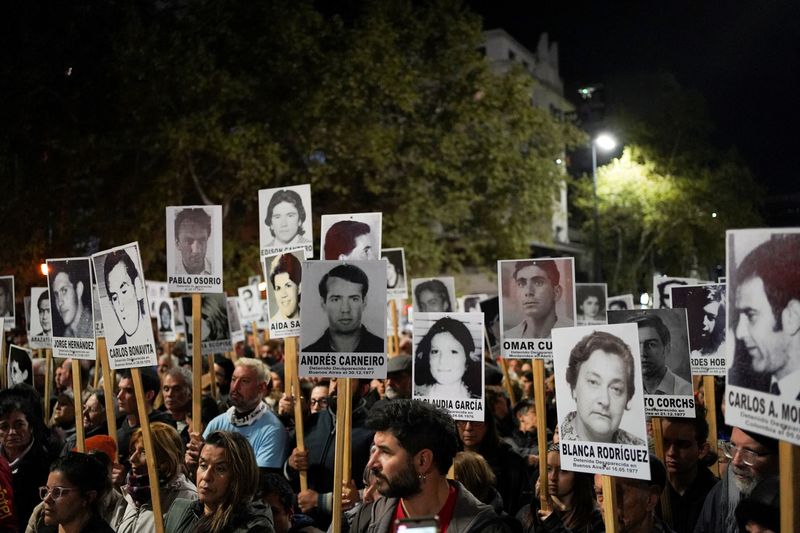By Lucinda Elliott
MONTEVIDEO (Reuters) -In Uruguay's cities and towns, paintings of white daisies, each with a missing petal, have appeared on walls and at windows in recent weeks, in memory of the people who went missing during the country's military dictatorship that began 50 years ago.
Tens of thousands took the streets of the Uruguayan capital on Saturday evening in a "March of Silence" to remember those who were forcibly disappeared by the state, both in Uruguay and in neighboring Argentina, during a wave of military rule in the region.
"This movement will not disappear, it is part of all of us," 22-year-old law student Elise Cierra said as people started gathering along the main avenue of Montevideo.
The Mothers and Family Members of Disappeared and Detained Uruguayans organization says 197 nationals were forcibly disappeared. Only six bodies of those who disappeared in Uruguay have been recovered so far.
Thousands more were imprisoned and tortured, and there is a growing call for more accountability.
"It is not only a march, it is becoming an entire month of memory," Ricardo Perciballe, the state prosecutor who has been seeking to bring those accused of crimes in Uruguay's 1973-1985 dictatorship to trial, told Reuters. The pandemic, he said, has reignited "our collective memory and desire for the truth."
Silent demonstrations have been taking place each year on May 20 since 1996, with protesters carrying pictures of the missing and demanding justice. This year - which marks five decades since the then-president, Juan Maria Bordaberry, dissolved parliament and suspended the constitution - is expected to draw much larger crowds than usual.
A giant installation decorated with images of the disappeared has taken over the popular Montevideo place name sign that overlooks Pocitos bay, and similar installations are planned in other cities.
"People are protesting in new ways because they feel part of something and are less fearful than before," said Ricardo Gomez from Images of Silence, an organization that arranged the Montevideo installation.
The topic of the dictatorship remains controversial in Uruguay, with some reluctant to revisit this sensitive period of the country's fairly recent history.
Some right-wing groups, such as the Cabildo Abierto party, say it is time to close cases related to the dictatorship and release convicted officers.
Other Uruguayans say those who committed crimes have still not all been brought to justice and the full truth revealed, said Perciballe.
Fewer than 50 people have been convicted of dictatorship-related crimes in the country, according to the prosecutor's office. There are around 100 pending cases.
Investigations into dictatorship-era offenses have only been allowed since 2011 when an amnesty law was declared invalid.
Members of the Mothers and Family Members of Disappeared and Detained Uruguayans have criticized the state for not dedicating more resources to looking for those who disappeared and investigating human rights abuses.
The defense ministry and presidency declined to comment, but Defense Minister Javier Garcia has said the administration of President Luis Lacalle Pou, who took power in March 2020, has done more to deliver information about people who remain unaccounted for in two years than in the previous decade.
The white daisy emblem with the missing petal, adopted in 1997 a year after the first march was held, keeps discussions about that period alive, including among younger generations.

"My daughter asked me what the flowers meant the other day," said Natalia, a 41-year old mother-of-two who grew up in Montevideo, asking not to use her family name. "It has become an important talking point."
Saturday's commemorations confirmed "the values of justice, memory, truth and reparation," in Uruguay, according to local historian Gerardo Caetano, who said he had noticed "more and more young people committed."
